The spruce is an evergreen coniferous tree genus found widespread in the northern hemisphere. Some varieties of spruce can grow to 60m. when mature and have a typical conical shape. The branches grow whorled. Their needle-shaped leaves are four-sided and attached singly to the branches. They stay on the tree for 4 to 10 years. The cones hang downwards. The branches bend downwards at their base but their tips point slightly upwards.
They can be distinguished from the pine family by their needles (leaves), which are four-sided and attached singly to small persistent peg-like structures (sterigmata) on the branches, and by their cones (without any protruding bracts), which hang downwards after they are pollinated. The needles are shed every 4 – 10 years leaving the branches rough with the retained pegs.
Spruces are not very easy to style as bonsai:
- They hardly back bud at all.
- Wired branches revert back in their original positions time and again.
- They suffer from unpredictable dieback meaning you easily and for no obvious reason lose vital branches.
- Trunks have a very poor taper.
There are however wonderful examples of spruce bonsai, especially using the Japanese species Picea jezoensis and Picea glehnii and the European Picea abies (Norway spruce). There are also a number of dwarf slow growing species that make very attractive small trees but not good bonsai as they do not style well. Picea glauca 'Conica' however is often tried but rarely makes good bonsai. The Picea mariana (black spruce) is frequently used in the U.S.A. and Canada. Frequently encountered in garden centres is Picea glauca var. albertiana 'Conica', - (Dwarf Alberta spruce). It is a slow, growing conical plant with tight uniform branching holding light-green juvenile foliage and looking very good when small and young; however it will not progress beyond that stage without some dedicated effort and the end product is seldom worth the time and effort involved. It grows just 2 inches per year.
Bonsai care for Spruce bonsai trees:- Position spruce in full sun during the growing season. In winter some frost protection is recommended when in a bonsai pot. Frozen roots cannot provide water while the evergreen foliage continues to transpire and can desiccate.
- Water the spruce as soon as the soil gets dry, but do not keep the roots soaking wet. In winter water less but never let it dry out completely.
- Apply solid organic fertilizer every four weeks or use a liquid fertilizer every week during the growing season. Spruces also benefit from leaf feeding which improves leaf colour. Use a good liquid fertilizer with chelates and iron for spraying it over the foliage.
- Pruning and wiring is difficult because of the whorled growth; there are always several branches growing at the same height on the trunk. In the lower half of the bonsai tree you should keep only one branch of a whorl. Pinch new shoots in spring when they are still soft. If you want to prune back long branches, shorten them to smaller twigs near the trunk.
- Remember that the spruce will not back bud from old wood; always leave needles and buds on a branch you want to keep. Spruce have supple branches, they can easily be bent without snapping or cracking. In their natural habitat loads of snow fall on the trees and bend their branches downward. When the snow thaws, the branches come up again. For bonsai styling this means that thinner branches can be bent and twisted in any direction. Unfortunately wired branches often take years to hold their new position, repeated rewiring is necessary. Don't wire spruce in midsummer because dieback can occur at that time.
- Repot the spruce every two to four years. Prune the roots of a spruce only slightly as older trees will not tolerate loosing roots. Use a well-drained soil mix.
- Pests and diseases are numerable - green spruce aphids, spruce spider mites, gall adelgids, spruce needle miners, spruce budworms, diverse caterpillars and several fungal diseases like rust or needle-cast can harm the spruce.
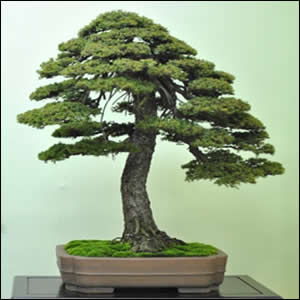
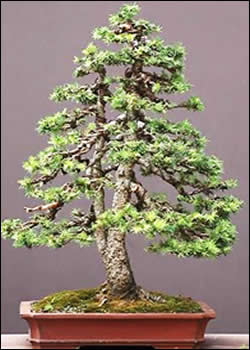
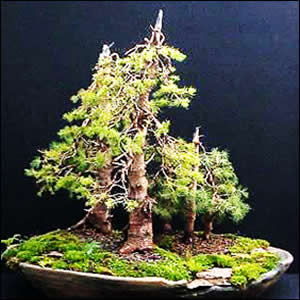
Styles are limited due to the growing nature of the species; it is more rewarding to go with the natural styles of the tree.
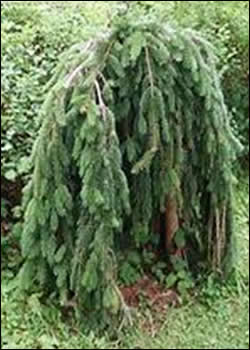
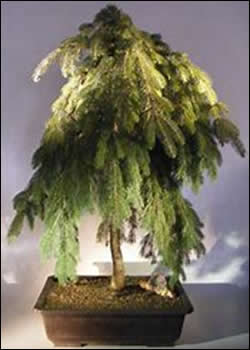
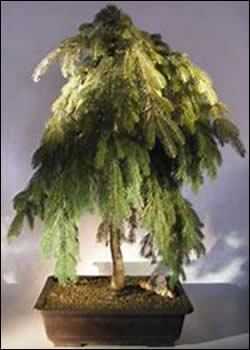
Bonsai based on the naural style of growth of the Norway spruce.

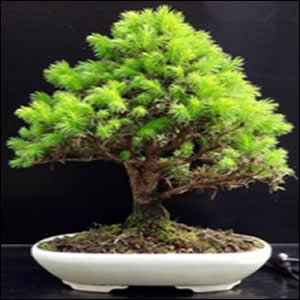

Abies albertiana retaining their natural growth style
Picea Glehnii native to Japan, has a slightly different growth pattern to the foliage whorls. Known more frequently as the ‘Ezo’ spruce and famous for many specimen trees in Japan.
The tree is shadow and frost tolerant, relatively easy to keep healthy but not easy to train; is can be very time demanding as trimming must be constant in order to retain its’ shape.

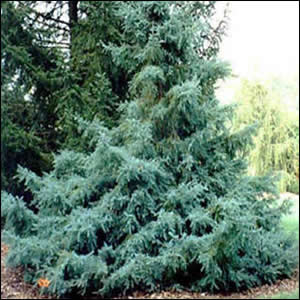


Web design: nysys